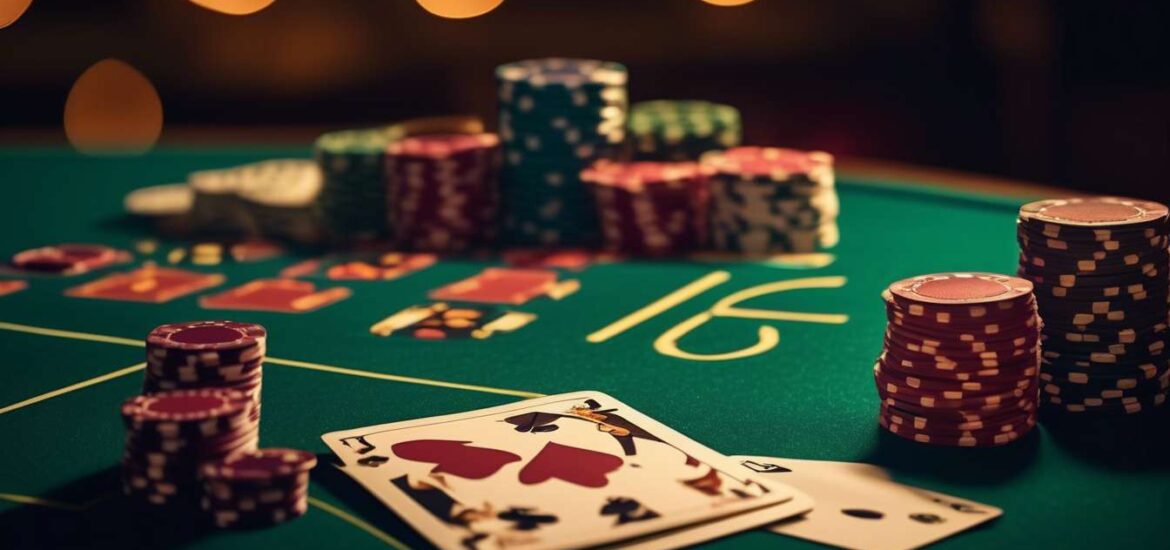When we step into a casino, the thrilling atmosphere and the clinking of chips set the stage for an exciting game of blackjack. As players eager to enhance our skills, we understand that a solid grasp of the blackjack basic strategy chart is crucial.
This chart, developed through meticulous calculations and probability theories, serves as our trusty guide, helping us make the most statistically favorable decisions in every scenario. By following the chart, we aim to reduce the house edge, increasing our chances of walking away with a win.
In this article, we will explore how to effectively use the blackjack basic strategy chart, breaking down its components and explaining how it informs our gameplay. Whether we are seasoned players or newcomers eager to learn, mastering this strategy is essential for optimizing our experience and success at the blackjack table.
Components of the Blackjack Basic Strategy Chart:
-
Understanding Your Hand:
- Different strategies for hard hands, soft hands, and pairs.
-
Dealer’s Upcard:
- How the dealer’s visible card influences your decisions.
-
Optimal Moves:
- When to hit, stand, double down, or split based on various scenarios.
Benefits of Using the Chart:
- Increased Winning Potential: By adhering to the chart, players can make moves that statistically favor their hand.
- Reduced House Edge: Consistently following the strategy minimizes the casino’s advantage.
Let’s dive in and unlock the potential of strategic play.
Importance of Basic Strategy Chart
A basic strategy chart is crucial because it helps us make optimal decisions in blackjack, improving our chances of winning. By following this chart, we can feel like part of a savvy group of players who understand the game’s nuances. It guides us to act with precision, taking into account:
- Our hand
- The dealer’s upcard
This shared knowledge empowers us, enhancing our sense of belonging in the blackjack community.
When we use a basic strategy chart, we’re not just guessing or relying on luck. Instead, we’re making informed decisions that put us in the best position to win. For example, knowing when to double down can significantly impact our success.
The chart outlines these strategic moves, giving us the confidence to play with purpose. By mastering the basic strategy, we collectively elevate our game, transforming our blackjack experience from casual play to expert engagement, and creating a bond with fellow players who share our commitment to winning.
Application in Different Hand Scenarios
In various hand scenarios, we can apply the basic strategy chart to make informed decisions that enhance our chances of winning. As a community of blackjack enthusiasts, we know how important it is to stick together and use every tool at our disposal.
The basic strategy is our roadmap, guiding us through the complexities of each hand. When faced with a challenging hand, the dealer’s upcard becomes our beacon. It helps us determine whether we should stand, hit, or even consider doubling down.
Key Strategies Include:
-
When the dealer shows a weak upcard, like a 5 or 6, doubling down can be a powerful move, allowing us to capitalize on the dealer’s potential bust.
-
If we’ve got a pair of 8s, the chart reminds us to split, creating two potentially strong hands rather than one problematic 16.
By following the basic strategy, we not only improve our odds but also strengthen our sense of community at the table.
Impact of Dealer’s Upcard
Understanding the Dealer’s Upcard
Understanding how the dealer’s upcard affects our decisions is crucial to implementing an effective blackjack strategy. In our community of blackjack enthusiasts, mastering the art of reading the dealer’s upcard allows us to make informed choices that align with the Basic Strategy. This shared knowledge empowers us, creating a bond among players who strive for excellence at the table.
Influence of the Dealer’s Upcard
The dealer’s upcard serves as a guide for our actions, influencing when we might consider Doubling Down.
- If the dealer shows a weak upcard, like a 5 or 6, we might seize the opportunity to double down on a strong hand, increasing our potential winnings.
- Conversely, if the dealer’s upcard is a high card, such as a 10 or Ace, we need to be more cautious, as the odds may not be in our favor.
Collective Strategy
By collectively understanding and reacting to these signals, we foster a sense of unity, elevating our game and standing together as a winning team.
When to Hit or Stand
Knowing when to hit or stand is essential for maximizing our chances of success in blackjack. By using the Basic Strategy, we can make informed decisions based on our hand and the Dealer’s Upcard. This approach helps us feel like we’re part of an exclusive club of savvy players who know how to play smart.
When the Dealer’s Upcard is weak (2 through 6):
- We typically stand on a hard 12 or higher.
- This strategy allows the dealer a higher chance of busting.
When the Dealer’s Upcard is strong (7 through Ace):
- Hitting might be necessary to improve our hand closer to 21.
There are times when our hand suggests we should consider Doubling Down, but that’s a topic for later. For now, sticking to the Basic Strategy ensures we’re making the right choices, minimizing our losses, and enhancing our sense of belonging among fellow players who understand the game.
With practice, these decisions become second nature.
Maximizing Wins with Doubling Down
To truly enhance our blackjack strategy, we can seize opportunities to double down when the conditions are just right. Doubling down allows us to increase our bet when we’re confident that our hand will beat the dealer’s upcard. According to the Basic Strategy, it’s a powerful move that can significantly boost our potential winnings.
When to Double Down:
- When the dealer shows a weak upcard, like a 5 or 6.
- When we have a strong starting hand, such as a total of 10 or 11.
In these scenarios, it’s an ideal moment to double down. We place an additional bet equal to our original wager and draw one more card, increasing our chances of securing a winning hand.
By sticking to the Basic Strategy, we ensure that our decision to double down is based on calculated probability, not just a hunch. This shared strategy helps us feel connected to a community of savvy players, all aiming to maximize their wins while enjoying the camaraderie of the blackjack table.
Strategies for Pair Splitting
Splitting Pairs in Blackjack
Splitting pairs in blackjack is a strategic move that allows us to turn a potentially weak hand into two opportunities for winning. By following the Basic Strategy, we can confidently decide when to split based on the Dealer’s Upcard.
- For instance, if we’re dealt a pair of 8s, it’s wise to split regardless of the dealer’s card. This move transforms a total of 16, a challenging hand, into two fresh starts.
- However, if we hold a pair of 10s, it’s best to stand and savor that strong 20.
Community and Strategy
Our sense of camaraderie grows as we master these strategies together. By sharing these insights, we create a community where we all thrive at the blackjack table.
- We know that when we spot a dealer’s weak upcard like a 5 or 6, splitting a pair of 2s or 3s becomes advantageous.
- Doubling Down after splitting can amplify our gains, but it’s crucial to assess the situation carefully.
Adjusting Strategy Based on Card Counting
Card counting allows us to enhance our blackjack strategy by keeping track of the cards played and adjusting our bets and decisions accordingly.
As a community of players aiming for shared success, we use card counting to advance beyond Basic Strategy. It provides the advantage of knowing when the deck is rich in high or low cards.
When the deck is rich in high cards:
- We might increase our bets.
- Opt for Doubling Down more aggressively, especially if the Dealer’s Upcard is weak—such as a 5 or 6.
By adjusting our strategy, we’re not just playing; we’re playing smart. Knowing when to tweak our approach helps us feel connected to the game and each other.
This strategic adaptability brings us closer to mastering blackjack together. As we continue to learn and support one another, card counting becomes more than just numbers—it’s our collective edge in the thrilling world of blackjack.
Tips for Efficient Chart Utilization
To make the most of a blackjack strategy chart, we should focus on familiarizing ourselves with its guidelines and practicing consistently. Understanding the Basic Strategy is key to feeling confident at the table. By learning how to react to the Dealer’s Upcard, we can make strategic decisions that bring us closer to belonging in the blackjack community.
Embrace the Chart as Your Guide:
- Keep it handy during gameplay.
- Quickly reference it to ensure the smartest moves, such as when to:
- Hit
- Stand
- Opt for Doubling Down
Consistent Practice:
- Helps internalize these strategies.
- Allows for more instinctive play over time.
Engage with Fellow Enthusiasts:
- Participate in discussions.
- Share tips and experiences.
- Enrich understanding and build camaraderie.
Together, we can make the most of the blackjack strategy chart and enjoy the game with confidence and skill.
Conclusion
In conclusion, mastering the blackjack basic strategy chart is essential for maximizing your chances of winning. By understanding how to apply the chart in various hand scenarios and adjusting your strategy based on the dealer’s upcard, you can make informed decisions on:
- When to hit
- When to stand
- When to double down
- When to split pairs
Remember to practice and incorporate card counting techniques for an added advantage.
Keep utilizing the chart efficiently to enhance your gameplay and increase your winnings.

